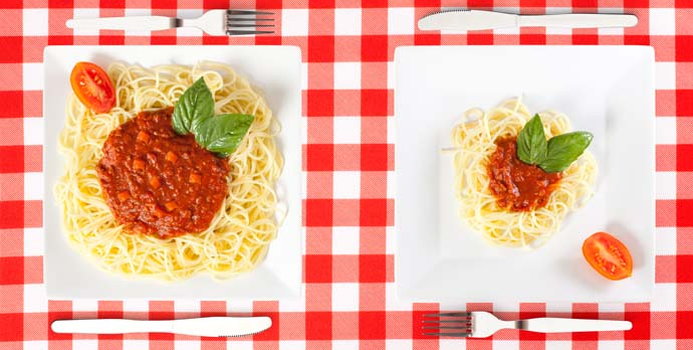Portion sizes have grown enormously over the past several decades, and the oversized portions we are routinely served at restaurants and fast-food establishments do not show any signs of shrinking. Nutrition and public health experts have long believed being served such huge portions has skewed our idea of what a portion should be. As a society, we have become numb to what a normal, healthy portion size actually looks like. In fact, oftentimes what is considered the appropriate portion of any given food item seems much too small because we have become accustomed to such cartoonishly-massive serving sizes of everything from pasta to soda.
There is certainly a correlation between the massive amounts of food we are served and the rising obesity epidemic. Experts in the field postulate that we are passively eating too much and that the food industry has a moral responsibility to start serving more appropriate portion sizes. Researchers wanted to investigate whether or not giving people smaller portions of foods would help “re-normalize” their perceptions of what embodies a normal amount of food, thus influencing them to select and consume a smaller portion size of that food the next time they eat and even further in the future.
The Study
This eye-opening study was published in the American Journal of Clinical Nutrition in April 2018 (Volume 107, Issue 4, 1 April 2018, Pages 640–646). This study involved three experiments that included 40 participants. The study participants were told that the aim of the experiments was to look at food, reasoning, and mood. The researchers told the subjects this in order to prevent them from knowing the real purpose of the study as this could have had a negative effect.
During the first experiment, the participants were served the same meal—salad and quiche—but one randomly-selected group was served a larger portion and the other group was served a smaller portion. The second experiment was held the following day. In this experiment, participants were told they could dish up what they wanted to eat in the amount they wanted from the same kind of food they were served in the first experiment the day before.
For the third experiment, which was performed one week later, the researchers asked the study participants which portion size of food they preferred to eat.
The Results
The results of this study were remarkable. Being served smaller portions not only changed the participants’ perceptions of what an appropriate portion size of food looked like, but it also correlated with them choosing smaller portions at future meals. One day after being served the smaller portion, they chose a smaller portion to serve themselves. Then, one week later they stated they preferred the smaller-sized portion of food.
Your food choices are driven by a host of factors, many of which are environmental in nature. Of these factors that the food industry can help change to hopefully mitigate the detrimental effects obesity has on our health as a nation, serving smaller portions that better align with what the United States Department of Agriculture (USDA) recommends as a proper portion size would likely be the most effective and easiest to implement as evidenced by the results of this study.
Simply being served smaller portions helps people choose smaller portions days later, without them even realizing it. If the food industry decreased portion sizes of many of the commercially-available food items, seeing these smaller portions may help you re-calibrate what a normal portion should be and help you eat less. This could have an enormous impact on the nationwide obesity epidemic because it could help curtain mindless over-consumption.
Results of this study suggest that it is possible, and fairly simple, for you to re-calibrate your perception of normal portion sizes, although the food industry would also need to take part in assisting with this process regarding our gauge of what constitutes a healthy, normal portion.
Applying This to Your Eating Habits
With a few easy strategies, you can help retrain your brain to recognize and serve yourself more appropriate portion sizes.
Break Out The Measure Cups
Those measuring cups and measuring spoons collecting dust in your cabinet can be used for more than just baking. Use these to start measuring out the correct portions of food onto your plate or in your bowl. For more information on proper portion sizes, visit https://www.choosemyplate.gov/.
Do The Splits—As In, Split Meals
While you can control the amount on your plate at home, you do not have much control over how much food you are served when dining out. Consider splitting an entree with a friend, family member, or colleague. You can ask the server to split the dish and it can be brought out on two separate plates (or bowls). Dining alone or the person you are eating with doesn’t want to eat the same dish as you? Simply ask for a to-go box as soon as your food arrives and box half of it up for the next day. Most restaurant meals can actually serve two to three people.
Invest In New Plates And Bowls
It may seem silly, but purchasing smaller plates, bowls, cups, and even silverware can help you learn to serve yourself smaller portions. Rather than filling a 12-inch diameter plate with food, opt for a 9-inch diameter plate instead and limit yourself to one plate of food. Physically, you won’t be able to put as much food on the plate and your perception of appropriate portion sizes will be changed for the better. Eating with smaller utensils equates to causing you to take smaller bites, thus helping you take longer to finish your meal and allowing your stomach to send fullness hormones to your brain.
[Image via Shutterstock]



